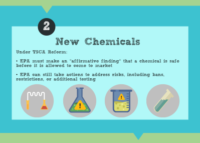On June 22, 2016, President Obama signed the Protecting Our Infrastructure of Pipelines and Enhancing Safety Act (PIPES Act). The law, which received strong bipartisan support, extends and funds through 2019 the gas and hazardous liquid pipeline safety program implemented by the Department of Transportation’s Pipeline and Hazardous Materials Safety Administration (PHMSA).
After 40 years, the Toxics Substances Control Act (TSCA) has been reformed in an effort to more effectively manage chemicals in this country and give EPA more authority to evaluate and mitigate the associated risks. This infographic summarizes the important points of TSCA reform.
Although a new occupant in the White House will likely lead to changes at the Department of Labor, OSHA’s latest regulatory agenda suggests the safety agency is not in lame duck mode. Keep reading to find out what rulemakings are on the front burner and what it means for you.
Referencing an opinion by the U.S. Supreme Court, the EPA is proposing to remove a restriction on when a Clean Air Act (CAA) Prevention of Significant Deterioration (PSD) permit may be rescinded. Specifically, the proposal would remove from 40 CFR 52.21(w) the provision indicating that a stationary source may request to have its PSD permit […]
The U.S. Army Corps of Engineers (Corps) is proposing to renew its 50 existing nationwide permits (NWPs) and to add two new NWPs. The existing permits expire March 18, 2017, and the Corps wishes to have the reissued permits effective immediately after expiration.
“For the first time in 20 years, we are updating a national environmental statute,” said President Obama before signing the Frank R. Lautenberg Chemical Safety for the 21st Century Act on Wednesday. The president noted that the updated law, the Toxic Substances Control Act (TSCA), which took effect in 1976 “didn’t quite work the way […]
There should be little difficulty understanding the pollutant effluent limits in the EPA’s final pretreatment standards for onshore unconventional oil and gas (UOG) extraction facilities because the limits are zero. The pertinent addition to the Code of Federal Regulations is as follows:
By Arielle B. Sepulveda On May 12, 2016, the Occupational Safety and Health Administration (OSHA) published a long-awaited final rule requiring certain employers to electronically submit injury and illness data, providing for such data to be made publicly available, and updating employee notification and antiretaliation provisions.
Back in March, the U.S. Environmental Protection Agency (EPA) proposed significant changes to the chemical accident prevention provisions, commonly referred to as the Risk Management Program (RMP). In a recent webinar, Risk Management Plan Updates: A Guide to Regulatory Compliance in Advance of EPA’s Final Rule, speaker Natalie VanLiew, PE, Managing Consultant at Trinity Consultants, […]
Recently, we received the following question from a subscriber about OSHA’s new Electronic Recordkeeping rule: What is the new OSHA tracking rule all about, and when will it go into effect? This was our response:










